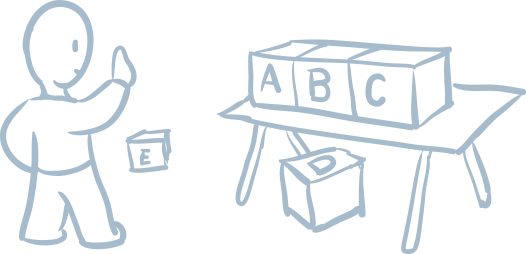Interlinking topics: not isolating mathematical patterns
We do not present isolated information to pupils: it is always present in a familiar schema – a schema the children can recall at any time. We do not set mathematical phenomena and concepts apart, but we adopt different strategies for solving them. Children choose on their own what suits them best and what feels most natural. You will not hear any of the typical: “But, teacher, we did that two weeks ago, we do not remember it any more...“
When we connect the individual topics with each other, especially using our own experience, we are easily able to deduce or recall a particular piece of knowledge. Conversely, when we learn specific facts or rules separately without really understanding them, we might, eventually, not be able to recall them at all.

When information logically interlinks
If we wanted to learn the schema of our house by learning about the windows in September, about the kitchen in October, about the carpets in November, and about the lights in December, in January we would have to review everything that we have forgotten about the windows, the kitchen, and the carpets. However, as we learn about our house directly in action, through everyday activities that are complexly interconnected, we can recall our house and its parts whenever we please.
That is so because we take an active part in these activities. They are naturally linked to different parts of the house, and a number of sub-schemata are interrelated with those parts. For example, hanging pictures on the wall is connected with the living room sub-schema and the windows sub-schema. Before we hang a picture, we want to find out where the daylight, and later the lamp-light, would be coming from; we might also consider how well the picture would match the existing decor, and so on. We know our house well, and we know its individual parts, even though we have never learned about them and never specifically focused on them. All this information is stored in the house schema and we can retrieve it at practically any time, even if it may take us a moment.
Different schemata facilitate better understanding
Our mathematics works analogically. We learn about new concepts, processes, problem-solving strategies, and phenomena in different environments, and we gain a good understanding of them by putting the puzzle-pieces of partial knowledge from the various environments, and from the various activities, together.
We will show two examples here. In the first example, we will show how one activity links to various areas; in the second example, how many different activities facilitate the formation of one piece of knowledge.
1. Paper-folding
In a very simple activity, such as folding a square-shaped piece of paper into two triangles, children use their experience to form:
-
geometric concepts – a square; a triangle; an isosceles right-angled triangle; the diagonal of a square; a vertex and the side of a triangle; the hypotenuse of a right triangle; area (a square can be made up of two triangles);
-
geometric relationships – congruence of triangles; a square can be decomposed into two isosceles right triangles, and vice versa; the diagonal of a square is longer than its side;
-
arithmetic concepts – number 2, i.e. two triangles; a fraction as a part of whole, i.e. a half of a square.
While manipulating the piece of paper, and trying to fold it as precisely as possible, children also work on their motor skills, which will be beneficial later for construction problems. This is a crucial point in all the problems presented through different environments – by solving a problem, children not only practise their calculation skills, but they also learn something on top of the problem’s main focus area. Each environment endows mathematics with something unique.
2. Addition and subtraction in different environments
In this second example, let us look at addition and subtraction, and the varied opportunities a child is given to encounter these operations:
-
activities in the Stepping and Staircase environments (making steps, clapping, counting off in the rhythm of steps, recording steps by drawing arrows);
-
acting and solving problems in the Bus environment (passengers getting on and off the bus);
-
working with Father Woodland’s animals (balancing out the strength of two teams);
-
in Spider Webs and other environments that deal directly with numbers (structural environments);
-
in geometric environments, which do not deal directly with numbers, such as Tiles (choosing the number of tiles needed to cover a specific floor), Wooden Sticks (take three sticks and make a triangle, take two more and make two triangles), Building Blocks (construct a building with three cubes in the first floor and two cubes in the second floor) etc.
Each of these environments contributes in a unique way to the understanding of the concept of a number, and of the basic operations of addition and subtraction. As a bonus, each also creates the conditions for a different problem-solving strategies.
